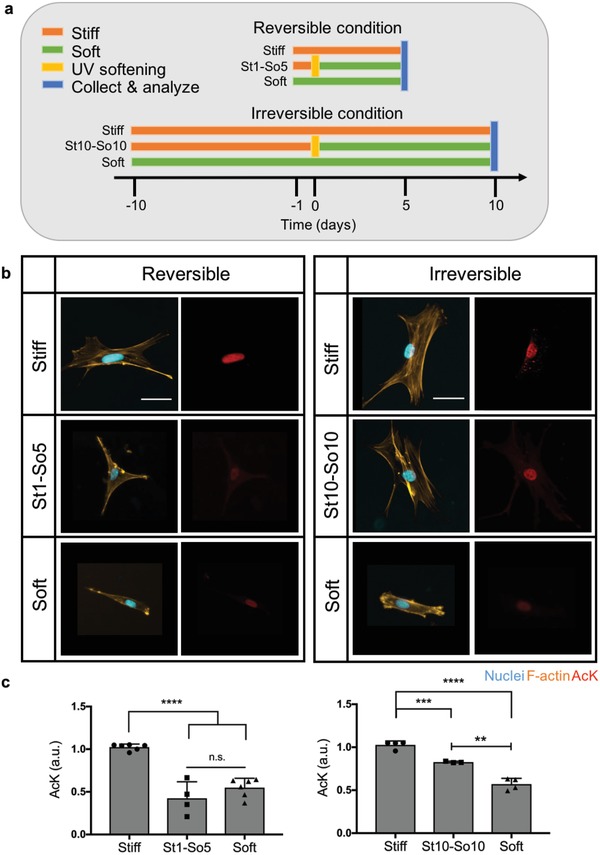Figure 5.

Influence of reversible and irreversible mechanical dosing on AcK modification. a) Experimental outline of reversible and irreversible condition based on YAP staining. E = 32.7 kPa for stiff and E = 5.5 kPa for soft hydrogel conditions. For the reversible condition, hMSCs were cultured on stiff hydrogel substrates (orange) for 1 d. Subsequently, hydrogels were in situ softened by irradiation with 10 mW cm−2 365 nm light for 2 min (yellow) and hMSCs were cultured for an additional 5 d on soft substrates (green) before collection and analysis (blue) (St1‐So5). For the irreversible condition, hMSCs were cultured on stiff hydrogel substrates for 10 d. Subsequently, hydrogels were in situ softened by irradiation with 10 mW cm−2 365 nm light for 2 min and hMSCs were cultured for an additional 10 d on soft substrates before collection and analysis (St10‐So10). Both the reversible and irreversible conditions have controls of hMSCs cultured on hydrogel substrates with constant stiff (E = 32.7 kPa) or soft (E = 5.5 kPa) moduli. b) Immunostaining of hMSCs cultured in a reversible or irreversible condition compared to their stiff and soft control conditions. hMSCs cultured in the condition that leads to reversible YAP signaling (St1‐So5) showed less AcK staining compared to the stiff control condition, but similar AcK staining as the soft control condition. hMSCs cultured in the condition that leads to irreversible YAP nuclear localization (St10‐So10) showed brighter AcK staining compared to the soft control condition, but less AcK staining compared to the stiff control condition. Nucleus (blue), F‐actin (orange), and AcK (red). Scale bars = 50 µm. c) Relative AcK intensity was quantified based on immunostaining for both reversible and irreversible condition. Softening after 1 d (St1‐So5 condition) allowed AcK levels to revert to basal levels for the soft condition. Softening after 10 d (St10‐So10 condition) resulted in AcK levels significantly above basal levels for the soft condition. n.s.: p > 0.05, **: p < 0.01, ***: p < 0.001, ****: p < 0.0001 based on a one‐way ANOVA followed by Tukey's post hoc test. n ≥ 3 with more than 100 hMSCs analyzed per sample. The data represent the mean value ± s.d.
